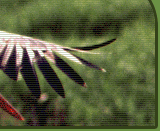Overgrowing of oak stands with bushes Description: Overgrowing with bushes that takes place in wooded meadows, oak forests and around separate oaks provide less favourable growing conditions that result in young oaks growing tall and thin or not surviving at all. The thin trees have considerably less volume than thick trees and have lower chance of various damages resulting in tree holes with the red rot. Overgrowing also creates a shading of trees reducing the direct sunlight that reaches the tree trunks. The shading prevents the trunks from accumulating the heat thus affecting microclimate inside the tree. Location: Sita and Pededze floodplains, Mugurve meadows, Pededzes lejtece, Rakupe meadows, Vidusburtnieks meadows Impact on habitat and species: Although Osmoderma eremita* may also inhabit thin trees, these may serve considerably shorter time period as hosts for the species. Also damages resulting in tree holes with the red rot, which is the living environment of the species, occur less frequently in such trees. As the natural dispersion ability of the species is very low, there is a high risk that the host tree may not support the population long enough for it to spread out to another tree or trees in the surroundings. The insufficient sunlight for oaks caused by overgrowing with bushes has a negative impact on living conditions of this species as well as its distribution possibilities. A direct sunlight that reaches the tree trunks heats their surface and the heat accumulates in the trunks providing the microclimate necessary for Osmoderma eremite* in the holes. Microclimate of holes in shaded trees is not suitable for the species thus reducing its survival possibilities. High temperatures are also needed for the imagos of the species to reach ability of flying. Beetles living in the shaded trees may not be able to reach the temperature necessary for starting the flight or reaching another suitable tree thus raising a risk for the population to become extinct. For the habitat type 6530* Fennoscandian wooded meadows this threat acts similarly as the decreasing of open meadow area, overgrowing with trees and bushes. | 







